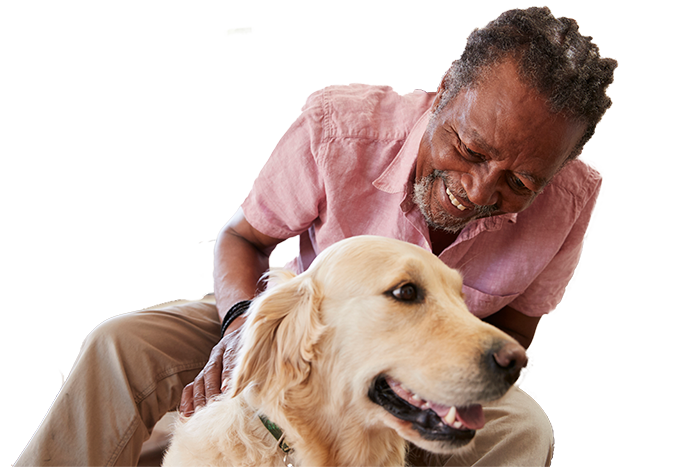If you would like to become a Pets As Therapy volunteer with your cat, please apply by clicking the ‘Apply with your cat’ button below.
If you're a cat owner aged 18 years old or over, have some time to spare and are interested in becoming a PAT Volunteer, simply complete our online application form.
Once we have registered your interest in becoming a volunteer, you'll receive a step-by-step guide on how to progress your application.
On completion of your application, you will receive your PAT lanyard and ID badges for both you and your cat. We will provide you with guidance on places you can visit and support you as you start your visits. Regular visits are generally appreciated, but there’s no minimum or maximum commitment. It’s up to you how much time you dedicate to volunteering. All we ask is that your cat has regular breaks and doesn’t work for more than two hours at any time.
-
Do PAT Cats need to be house cats?
No, PAT Cats do not have to be house cats, however we do not accept cats that are ‘known active hunters’.
Our definition of ‘known active hunter’ refers to a cat that is known/suspected by its owner to be a habitual successful hunter (ie. hunts at least once a month or more).
We understand that hunting behaviours in cats are natural, but cats that are habitual successful hunters (regularly bringing kill/prey home, etc) do carry a higher risk to our beneficiaries.
-
Is there an upper age limit for my pet to become a PAT Cat?
There is no upper age limit, however PAT Pets give so much during visits, so please consider the impact that visiting a new and demanding environment may have on your cat.
We understand this may be a disappointment, but the welfare of our PAT Pets must come first.
-
Is it a requirement that PAT Cats don't eat raw food?
Cats should be fed cooked or commercially processed food. We don't accept cats that eat raw food or unpasteurised products.
-
What does the Temperament Assessment entail?
Your assessment will take place in a convenient location, where you’ll meet an accredited Pets As Therapy Assessor. The assessment is straightforward, lasts around 45 minutes and enables us to make sure your cat is friendly, sociable and calm, and that it doesn’t mind being stroked or handled. Fit, healthy cats behave appropriately as PAT Cats under demanding social and physical situations. A clean, well-groomed cat is a sign of a responsible pet owner. Assessors are also asked to make note of any other behaviours that they may observe throughout the assessment, for example, jumping up, hissing or excessive licking. Such behaviours are not acceptable on Pets As Therapy visits.
For more information, please download our Temperament Assessment Factsheet.
-
Can my assessment take place at my home address?
Unfortunately we are unable to carry out an assessment at your home address. It is important that the assessment is carried out at a neutral location for you and your pet so our Assessor is able to assess your pet outside of their own environment.
-
What if my cat fails the assessment?
If for any reason your cat does not meet our assessment requirements and there is considered to be an unacceptable risk to the clients/patients that we are visiting, your cat will be deferred. Assessors are trained to conduct the test in such a way that all pets are assessed fairly and consistently. The behaviours that may result in a deferral include jumping up, excessive meowing or reluctance/backing away when being fussed.
Deferrals are discussed and considered very carefully and if your application is deferred, don’t worry, you’ll be invited to be re-assessed at a later date. For more information, please download our Temperament Assessment Factsheet.
-
How much does it cost to become a volunteer?
Volunteers are required to pay an annual contribution to the Charity, which is currently £25 (or £35 for a joint contribution). This goes towards the volunteer’s liability insurance. Expenses may be reimbursed by some establishments, but please enquire about this before you start visiting.
-
Do I have to buy branded PAT Volunteer clothing?
You are not required to wear any official Pets As Therapy clothing, but you must always display your ID badge while on visits. If you are to appear in a publicity or National Office event, you and your pet may be asked to wear official clothing that has our Pets As Therapy logo on it. If this is the case, you’ll be able to borrow the items you require from our extensive loan stock. If, however, you’d prefer your own items, a full PAT Volunteer and PAT Pet range is available to buy.
-
How often am I expected to visit?
There is no set requirement on how often you need to undertake visits on behalf of Pets As Therapy, but regular visits are greatly appreciated by all those who receive them. Please discuss frequency with the establishment before starting your visits. For further information, please contact the Pets As Therapy National Office.
-
What can I expect from Pets As Therapy?
As a Pets As Therapy Volunteer you can expect: • Fair selection and recruitment • A rewarding and worthwhile volunteering experience that benefits individuals and the community • Support from local volunteers (Voluntary Area Coordinators) and from the Charity • Due diligence for your health and safety • The Charity to recognise the rights, roles and responsibilities of you and your PAT Pet.
For more information, please download our PAT Volunteer Agreement Factsheet.
-
What does Pets As Therapy expect of its visiting volunteers?
As a PAT Volunteer the Charity expects you to: • Operate to the agreed standards and policies of the Charity and uphold the vision, aims and strategy of the Charity at all times • Work as an individual and also as part of a team • Abide by any requirements of the establishments you visit • Give the establishment notice of any absence or intention to stop visiting • Inform the Charity should you need to stop visiting • Take advantage of support and supervision offered and give feedback • Contact National Office for support and guidance if any problems arise.
-
I am a teacher, can I take my PAT Cat to school with me?
Unfortunately, due to insurance restrictions we are unable to support you if you wish to have your cat at your place of work. As a PAT Volunteer, your primary responsibility is to your cat and you are unable to do this if you are running a class or therapy session. If there was an emergency and the school had to be evacuated, as a volunteer you would be responsible for your cat, but as a teacher you are responsible for the children and therefore the welfare of either would be compromised.


